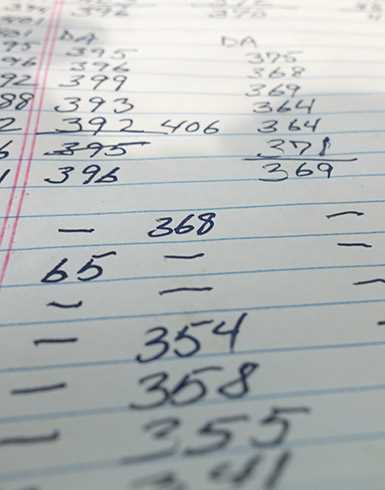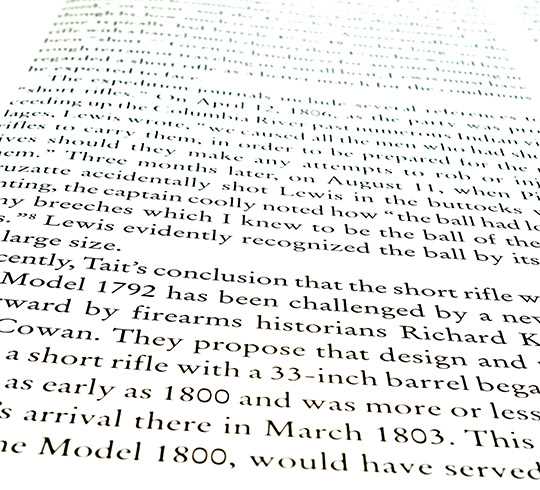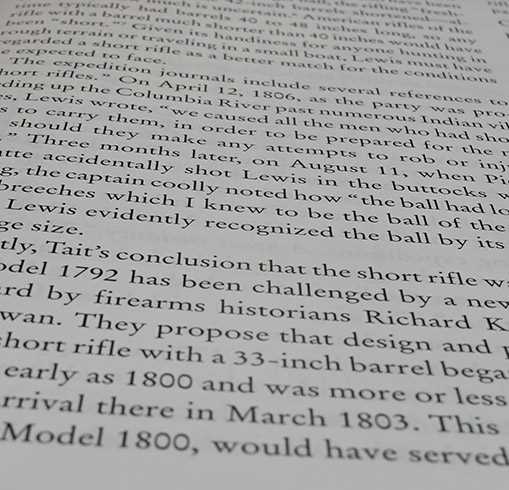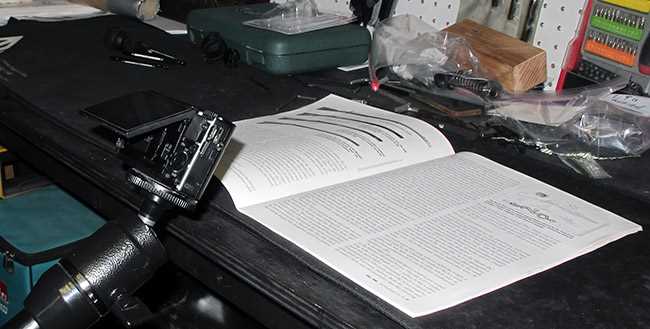This report covers:
- What is depth of field?
- Let me show you
- Focus remained the same
- No jargon
- Blinders
- The deal
- A test
- Summary
Today I’m addressing a question that came in about a week ago concerning depth of field. We were talking about peep sights in general in Part 2 of the Crosman Precision Diopter Sight System. I had said they can increase the depth of field for you. Here are some comments we got that led to this report.
| Decksniper BB People’s eyes can differ but for most folks does the 10 meter blinder or in your case the rubber cup affect sharpness of the front sight at 10 meters or even 25 yards? Or does it just help the rear peep do it’s thing, which is to bring both the front sight and target into clear focus? I ask this because with my astigmatism a peep dramatically helps me even on a pistol and a lens peep can sharpen a blurry red/green dot optic. Deck |
| Tom Gaylord (B.B. Pelletier) Deck, When you stop the light down with the black eyecup you increase the depth of field. I will try to show this in a report. BB |
| Decksniper BB Oh boy! Looking forward to it. Thank you, Deck |
| BB I would be interested seeing how you show that also. The depth of field. Gunfun1 |
GF1,
I’ve done it before with a film camera. Digital cameras are so sophisticated; I hope I can do it with them.
BB
BB
Ok hope so too. Will be waiting.
What is depth of field?
Depth of field is the range of distances at which things are in sharp focus. It’s easy to demonstrate with a film camera that has all manual controls. But with a modern digital camera it’s much harder to achieve because the camera acts like your brain. It optimizes everything, the light, the focus and the length of time at which the image is exposed and some other things that will come up in this report.
However, BB Pelletier, being the boss clown of this outfit, put on his big girl panties and set to the task. I could have done a little better if this was all that was on my plate, but, like all of you, I’m a very busy boy.
Let me show you
They say a picture is worth a thousand words, so here come three that illustrate my point.

I was just fooling around, trying to see what I could do to illustrate what depth of field is when I took this picture. The numbers 65, 368 and 396 are in focus. The numbers closer to the camera and farther away are out of focus. This is a narrow depth of field.
To increase the depth of field you need to do several things. Reduce the size of the hole through the camera lens, and increase the exposure time to allow the image to resolve. In a camera this is done by selecting the smallest exposure hole you can get with the lens that’s on the camera. If you have a film camera you need to consider the “speed” of the film, which means how fast it exposes in light to create an image. That is done by holding the shutter open long enough for the light coming through the lens to react with the film.
When you see, your brain does all of this for you — it sets the speed of the “film”, opens the hole in the “lens” and corrects the exposure in all other ways. The thing is, you don’t usually see the world in still photos — you see video. So your brain is working fast and sliding parameters around to keep the images sharp. Focus on something closer or farther away and your brain takes care of everything. To you the world looks “normal.”
A digital camera does many of those same things for you unless you override its automated features. And even then there are some things that cannot be overridden. The camera wants your pictures to be in focus. Usually that’s what I want, as well, but not for this report. So I had to learn how to overcome as many of the automated background features as possible to get what I wanted.

By opening the hole through the lens wide and speeding up the digital “film” I forced the camera to “see” a narrow depth of field.

By making the hole smaller through the lens I increased the depth of field. I also decreased the speed of the digital “film” and exposed this image much longer.
Focus remained the same
The focus for both pictures was the same. What made the depth of field increase in the lower picture were the things mentioned in the caption for that picture.

For both pictures shown above the camera was in the same position. All that changed are the things mentioned in the caption of the previous picture.
No jargon
I have purposely avoided as much jargon as possible in this report. Talking about things like ASA/ISO, shutter speed and f-stops only serves to confuse people, so I avoided them. Photographers speak in such terms, but they are talking about the same things I have mentioned in this report.
Blinders
Okay, I’m changing the topic a little, though what I’m about to say relates to what’s been said so far. What does a blinder do? It allows you to keep your non-sighting eye open while sighting through a small peephole. I have read where people have said that the blinder allows more light to come into your eyes and that is what helps you sight. That, they say, is why a light-colored translucent blinder is better than a dark blinder. BB says, “Hogwash! It ain’t true.”
What the blinder does is prevent a second image from confusing you when you are trying to see the front sight and target through a small peephole. Why a small peephole, you ask? Because that reduces the amount light coming through to that eye, causing your brain to adjust the pupil of your eye to expose the image over a longer period of time and THAT increases your depth of field! Now that you understand what depth of field is, you realize how a smaller peephole lets both the front sight and the target to be in relatively sharp focus.
The deal
Why not just close your non-sighting eye in a prolonged wink? Here is the deal. If you squint your non-sighting eye you also squint your sighting eye. Some are better at controlling this, but we all have this tendency. What it does is cause the peephole to let less light pass through to your sighting eye. While that sounds like a good thing, it’s not. The problem is, your sighting eye opens and closes just a little throwing off the light coming through and messing up your sight picture.
A test
Take a small card — business card size — and punch a hole in it. The hole does not have to be perfectly round. You can punch it with a ballpoint pen if you like. Hold the hole up to your sighting eye and try to close your other eye by winking. You will see that the hole gets smaller and darker around its edges as you do this. That’s what squinting does when you shoot with a peep sight. Not good!
Summary
I hope this report has helped you understand what depth of field is and how it comes about. If you use peep sights, this is why using them correctly matters so much.


Dear Boss of this clown outfit,
Only recently, last 3-4 months, have I been shooting through my scope with both eyes open. Not as hard to do as I initially thought. My one observation though is that my head needs perfect placement. Even a mm or 2 off and my scope image fades in and out.
-Y
PS.I still “wink” when open sight shooting.
Yogi,
If your scope goes dark with just a small movement, it’s a good one! That’s one of the defining characteristics.
BB
BB,
Those pesky robots are still around. Maybe they think they can entice readers to click on their name to go to their site?
Is it better to block the non shooting eye with a blinder at the shooting glasses or is it better with a blinder affixed to the rear sight? Arrr… I can imagine myself having an eye patch everytime I go shooting. Maybe also a parrot on my left shoulder?
Siraniko
PS: Section Let me show you 3rd paragraph 1st sentence: “When you see, your brain doesall (does all) of this for you-“
Siraniko,
I fixed the typo.
As for the pesky ROBOTS — they are an intentional insert. I’ve found them from many years ago, where THEY thought I wouldn’t notice.
We are working on them.
BB
Yep. The parrot holds the pellets
B.B.,
Whether using peep sight or scope, I have always shot with both eyes open, because I always shot better that way. But it was nice to read a detailed explanation of why that’s the case.
I also enjoyed your explanation of digital versus film cameras, from which I derived the following:
“The old dave-brain is SLOW…the digital camera brain is much faster…it takes the poor quality dave pics, and fixes the depth of field so correct items are in sharp focus.” Hahaha!
Yes, some day I would like to get, and learn to properly use, a nice quality film camera. Meanwhile, the pics I take with the Lumix digital camera (a wife gift…hence, it must get used!), such as the initial testing of the Crosman 362 and the pic of the doe in our backyard next to the cat-feeding station, are likely much nicer than they would have been with a film camera…at least till I “get me some learnin’.” 😉
Take care & God bless,
dave
Dave,
Old BB is still trying to figure out his Lumix. It seems to be better at video than stills, but it’s probably good at both. BB’s not, though! 😉
BB
B.B.,
All my stills with the Lumix (model DC-FZ80) were initially awful (of course, I didn’t actually read the manual…we’re guys; “we don’t need no stinking manual!”). An online Lumix blogger clued me in that, even if I was mostly using the “Intelligent Auto” mode, I still needed to manually dial the camera in once for proper focus. After I did that, it worked quite well, except that the dial would move every now and again. So, I glued it in place (“we’ll show that stinking dial who’s the boss!”), and it’s been fine ever since, hahaha! 🙂
Blessings to you,
dave
Dave,
Bless your heart! BB will take all the advice he can get.
BB
*thumbs up* 🙂
BB
Thank you for this excellent and clearly in focus explanation of vision depth of field relating to our favorite sport.
“Why a small peephole, you ask? Because that reduces the amount light coming through to that eye, causing your brain to adjust the pupil of your eye to expose the image over a longer period of time and THAT increases your depth of field! Now that you understand what depth of field is, you realize how a smaller peephole lets both the front sight and the target to be in relatively sharp focus.”
Your quoted words above are very helpful for me. I’m wondering if a black pirate’s patch is better than a dark blinder attached to glasses lens. I also wonder why a peep doesn’t work for you on pistols. I seem to remember your saying that. Until now I guessed you didn’t have astigmatism.
Again, thanks for taking the time to do this report. I’ve never seen a layman’s explanation on the subject until now.
Deck
Deck,
Oh yes, I have astigmatism.
Really? A peep on a pistol? How close does your eye get to the rear sight on a pistol now? Mine is about 20 inches, give or take. How are you going to sight through a peep at that distance?
BB
I guess it works when the peephole is big enough… 🙂
hihihi,
The peep hole option on 1322 seems to be more useful with the carbine stock.
BB
I get as close to the pistol peep as I want. Easy to do sitting down and pistol resting on a bag. At 20 inches you could be shooting offhand and maybe standing. Great if one can shoot like you did in competition. Okay for me if just plinking but too much whole lot of shakin goin on in this 83 year old body to shoot a tight group unless pistol is rested.
Deck
Deck,
Kinda like that Jerry Lee Lewis song, Whole Lotta Shakin’ Goin’ On.
BB
BB,
Would this work for pistols?
Siraniko
BB
Thanks for the report. Glad you got your digital camera to cooperate.
I wonder whether the brightness of the sight picture is optimised when the non-sighting eye is blacked out, ie the size of both pupils adjust to only the light that the sighting eye receives?
hihihi-
Instead of thinking of ‘blacking out’ the non shooting eye as in limiting the amount of light it receives, we should think of limiting the amount of information being transmitted to the brain. BB has covered the reasons why squinting is not optimal. Best shooting is when both eyes remain open. When teaching new or young shooters, I use a patch of masking tape on the lens of their safety glasses. Both eyes are receiving roughly the same amount of light, keeping pupil size equal. As always, more than one way to skin the cat. The blinder attachment for rear sights, flip up/down eyeglass attachments, a smear of Vaseline on the lens, etc., all occlude the view. Only the info from the aiming eye gets through, allowing the brain to concentrate on the sight picture.
pacinohio, I agree.
Any effect to suppress target information from the non sighting eye, reduces distractions, which must be particularly helpful for those who are right handed and left eye dominant – like me – or vice versa.
So, assuming one has succeeded in being able to fully concentrate on the correct peepsight picture, then, I imagine, that this would appear in perfect brightness when the pupils adjust to it’s light intensity (and nothing else).
The Daisy 230 I just bought is a pretty good shooter. Missing front sight. All the screws were loose and it is missing the nut on the barrel pivot screw, but after a few shots she really settled down. She does not seem pellet picky, but last night she did her best with HN Sport .22 wadcitters. I put some pellgun oil down the barrel to moisten the seals and we will see if there is any improvement tomorrow. There is a bit of rust here and there, so I assume there is some inside the barrel, too. Will clean with JB and see what happens. But I am pleased with this little gem!
Congrats to you; she looks like a sweet little rifle! 🙂
Well, best way for FM to find out what works is to experiment to see what helps the gooder right eye sight better without squinting with the left. While he’s at it, maybe will bring the old film camera out of retirement and play with it a little bit.
B.B. and Readership,
In the What Do You Like blog a very interesting exchange happened after most readers stop reading the comments between HiHi, Bob M and FawltyManuel. I responded to their conversation but will also share my reply here…it (the exchange) may provide Michael and others some Impetus to stay with the blog if he (they) chooses to read it:
“My Father taught me not to think of the Left — Right as being a linearity. He said that World View was a method used to fool us sheep into believing they (the Left & Right) are Polar opposites instead of the fellow travelers that they in fact are on the Totalitarian Path. His lesson was that the political paradigm is circular with moderate people at the top of the circle and the Totalitarian “LEFT” and “RIGHT” at the bottom. After much thought I have added to his lesson the idea that it is actually a globe or sphere with many paths to the opposite poles. Interestingly it is a long climb to be a true Moderate and an easy slide to the bottom.”
shootski
For anyone that isn’t already aware, if you forget your reading glasses and have to read a menu or something like that, there is a trick that can get you by. Use a ballpoint pin, a pencil, a hairpin or the tip of a pointy pocket knife blade to poke a tiny hole in a piece of paper or cardboard. When you hold the hole up to your eye the menu will be focused, although dim, and can now be read. If you don’t have anything to punch a hole with, you can put the pads of both thumbs and index fingers together as if you were holding a pinch of salt. Now bring the two hands together so the space in front of the two pinched areas look like they are kissing and form a diamond shaped hole. Now push it together hard enough to make the hole tiny. Then just look through it and ignore the weird looks you might get from the people around you. You can also make the OK sign and squeeze it down to a tiny hole down where the thumb and index finger emerge from the hand and look through that hole. That technique frees up one hand for positioning the thing you’re trying to read.
When adjusting the adjustable ocular on binoculars you will get a better result if you leave both eyes open and use a lens cover to block the lens that isn’t being adjusted. Start with the side that has a fixed ocular (little lens) and focus it with the cap still on the other side of the binocular. Once that’s focused, cover it and adjust the diopter of the other pair of lenses. Closing your eye causes a squint and apparently some flexation in the lens of the other eye that changes its focus. At that point you’d be focusing your binoculars with one eye artificially focused differently than it will be once you open both eyes. It would be like wearing your buddy’s glasses while you focus the binoculars, taking them off and then trying to see clearly through the binocs.
That’s kinda relevant to a discussion of peep sights and f stops, right? 😉
Half
Half,
Great points and tips…if your Smartphone battery dies or you left it at home. If you have the dang thing then use the camera and you can zoom to see the tiny stuff!
shootski
Been there done that
Shootski,
You’d be amazed at the number of people I know that don’t have smartphones. I learned those tricks long before I had a smartphone. High school physics in the very early 70s, if memory serves. Maybe even in an elementary school discussion of the amazing pinhole camera, way back when that sort of discussion was the important aspect of education. Will we ever get back there, I wonder?
Half
Half,
I remember that!
Maybe if we all wish hard enough it will happen!
I know that in the US Navy we learned how to use lots of “simple low tech” navigational tools and managed to get where we needed to go without aircraft and shipwrecks all too often compared to the recent high-tech systems based navigation record of spectacular failures. I hear tell they are bring back most of the old methods to at least teach situational awareness.
Could this be an analog to the Fall of Rome? I hope not!
shootski
Well my Dragonfly 2 is on the way. Got the tracking number today. Suppose to be here this Saturday and I just ordered it last night..
Hope it does make it Saturday. The kids are coming over Sunday for Father’s day. I’m sure it will get a work out if it makes it by then.
I think it’s a good airgun other the funny front sight. I liked what BB wrote about it. I wonder if yours will be accurate.
Lexi
Hopping it will be accurate too. 🙂
GF1,
Mine is on the way also. Hope we both get a good one. I plan to keep some high pressure grease on the pivot pins, maybe even some moly.
Don
Don
I hope we do get a good one.
Haven’t thought about the lube yet on the pivot points and such.
Let us all know when you get yours.
Gunfun1,
As for the pivot point lube the manual is kinda conflicting, quote from the manual;
“To maintain top shooting performance, lightly oil the
three pumping lever hinges and the felt wiper on the
piston every 500 shots (Fig 10).
DO NOT use light, household type oil or aerosol type
spray lubricants since they may contain substances
or additives harmful to the rubber seals or other
components. DO NOT use any lubricant containing
petroleum.”
But it then goes on to say use petroleum lube, quote from the manual;
“Approved lubricants include: 10-, 20- or 30-weight
non-detergent, automotive motor oil and pure silicone
lubricants.
I am confused, see the manual over here; /airgun-resources/manuals/AV-DragonFly-MK2-manual_(2).pdf
Mike
edit to add
that link does not work for whatever reason but you can get to the manual from the Dragonfly Specifications page over here: /product/seneca-dragonfly-mk2-multi-pump-air-rifle?m=5170
Mike
Maybe should treat a multi pump like a pcp and just use silicone oil anywhere it needs lubed ???
BB
Is moly the right or wrong viscosity for reducing wear at cocking pivot points? Not talking about seals, just metal on metal.
Deck
Deck,
Moly is a powder. It has no viscosity.. It’s good for cocking pivot points except the tight joints where it can’t get in. For them use plain household oil.
Whoever proofed that manual wasn’t a shooter and certainly not an airgunner. They are concerned about getting petroleum oil into the pump piston compression chamber. Heck — I regularly oil the felt pump head washer with Pellgunoil. The max pressure a multi-pump achieves is around 1,200 psi, according to W.H.B. Smith and the laboratory he had test the Supergrade.
BB
BB
Thanks. I won’t be reluctant to using a little 3 in 1 oil followed by a dab of PA moly paste on metal to metal pivot points.
Being this is a weekend I’ll be watching to see if others will chime in, even Michael maybe. Thank you again for your depth of field report. It is a keeper for me.
Deck
Deck,
Molybdenum disulfide greases are great for roller bearings and other highly loaded surfaces and is very good at preventing galling of SAME metal to metal surfaces.
A caution:
“Greases containing molybdenum disulfide shouldn’t be used in applications that see excessive amounts of water ingress as the molybdenum disulfide can have a corrosive effect of the metal surfaces, and is not suited for bearings and other components that move at a rapid pace.”
So no fast cocking or pumping and keep it out of the rain or the lake!
shootski
Shootski
While my hunting days are just good memories I do get to shoot even more now. My guns don’t get rained on but some day they may go hunting in someone else’s hands. Even now there is the chance of condensation moving to and from outdoors/indoors.
Do you use metal to metal moly paste anywhere on guns?
Thanks,
Deck
Deck,
Ran out of thread: https://www.machinerylubrication.com/Read/28381/grease-lithium-production-resistance#:~:text=The%20dropping%20point%20of%20lithium,azelaic%20acid%20or%20adipic%20acid.
I remember almost going the Moly route a few decades back but the way Moly plates metal surfaces always bothered me. At that time I was using small arms in very cold places and needed to run them with nothing or dry lubes only. Not being able to get the Moly off was a deal breaker. I stuck with graphite, PFFT, Lithium and Silicon lubes. Even the bullet World has given up mostly on Moly.
I use Lithium complex grease or Silicone these days; cleaning (stripping) reapplications are the real key to keeping galling at bay IF the manufacturer didn’t choose metals that play nice with one another. The other important thing to remember is that this stuff has a real shelf life that you need to consider. Cheaper to dispose of it when in doubt than to find out on your airgun! Machinery Lubrication has been a resource of mine for years. Maybe Gunfun1 will add some sources too.
shootski
Shootski
Interesting Machinery Lubrication article on lithium. My thoughts on using Moly on gun cocking link pivots are on hold. Do you use either silicone or a lithium complex grease on the roller or cam bearing lockup of a break barrel airgun?
Deck
Deck,
Just got around to answering you on what I currently use. I only have the two SIG ASP20s and haven’t lubricated them. The link below is to an interesting “History of Lubrication” and the part about Military Lube needs for small arms is the most interesting part. Since SIG is so heavy into Military Equipment manufacturing they probably used that lube knowledge on the pivot as well as the cocking shoe (Pot Metal — I seriously doubt that is what it actually is composed of) that Tom covered at length. I think just like their LASER Welding and barrel technology I’m not going to mess it up with some outdated and old technology grease.
https://mil-comm.com/lubricants/the-ultimate-historical-timeline-of-mechanical-lubrication/.
I have used the SIG lubricants as well as the Mil-Comm products (both lubricants and cleaners) extensively. I’m trying to figure out how to use air bubbles for my kayaks to get better top end speeds…LOL!
shootski
Shootski,
Thanks for that a long but very good read.
As for the air bubbles to increase your kayak speed perhaps a second hull with thousands of tiny holes expelling HPA to keep you floating on a cushion of air like an air hockey puck floating over the board. LOL May be it could work.
Mike
Shootski
I just discovered your reply. Usually I get an email but not this time. Thanks for posting the lube history which I look forward to reading.
I bought a large jar of a lithium complex at an auto Alliance shop and tried a small amount on the lock up of break barrel that requires bumping to unlock. The difference was significant so I used it on several others, all became smoother.
Good luck with the air bubbles and thanks.
Deck
BB, this is just plain ol’ GOOD WRITING! Clear, easy to understand, illustrated to clarify points, and interesting. You usually do a fine job, but I usually have a good handle on the subject matter. Most of these concepts were new to me, and I was able to get a good “focus” on them with your help. Thanks! Edith is smiling!
Bejezus,
That is one of the nicest compliments I have ever had. Thank you! 🙂
BB